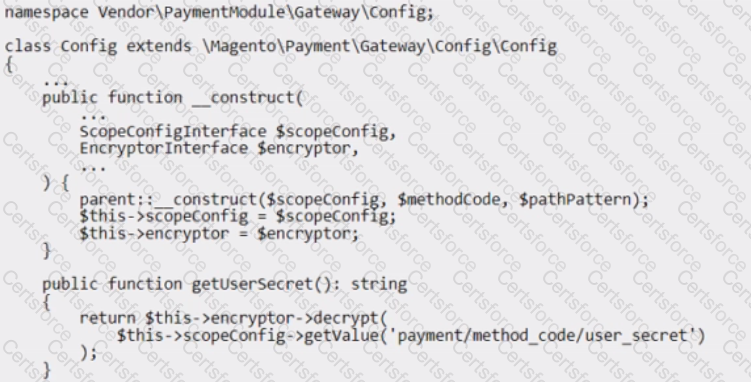Since the last production deployment, customers can not complete checkout.
The error logs show the following message multiple times:
main.CRITICAL: Report ID: webapi-61b9fe83f0c3e; Message: Infinite loop detected, review the trace for the looping path
The Architect finds a deployed feature that should limit delivery for some specific postcodes.
The Architect sees the following code deployed in etc/webapi_rest/di. xml and etc/frontend/di. Xml

LimitRates.php:

Which step should the Architect perform to solve the issue?
An Architect agrees to improve company coding standards and discourage using Helper classes in the code by introducing a new check with PHPCS.
The Architect creates the following:
• A new composer package under the AwesomeAgency\CodingStandard\ namespace
• The ruleset. xml file extending the Magento 2 Coding Standard
What should the Architect do to implement the new code rule?
A)

B)

C)

An Adobe Commerce Architect is asked by a merchant using B2B features to help with a configuration issue.
The Architect creates a test Company Account and wants to create Approval Rules for orders. The Approval Rules tab does not appear in the Company section in the Customer Account Menu when the Architect logs in using the Company Administrator account.
Which two steps must be taken to fix this issue? (Choose two.)
In a custom module, an Architect wants to define a new xml configuration file. The module should be able to read all the xml configuration files declared in the system, merge them together, and use their values in PHP class.
Which two steps should the Architect make to meet this requirement? (Choose two.)
An Architect needs to create an additional regional UK website with its own website currency set to GBP in Adobe Commerce. An existing US website is using USD as a default base and website currency.
After the first week of sales in the new UK website, an administrator notices that all sales totals in Sales Orders report show £0.00.
How should this issue be resolved?
While reviewing a newly developed pull request that refactors multiple custom payment methods, the Architect notices multiple classes that depend on \Magento\Framework\Encryption\EncryptorInterface to decrypt credentials for sensitive data. The code that is commonly repeated is as follows:

The Architect needs to recommend an optimal solution to avoid redundant dependency and duplicate code among the methods. Which solution should the Architect recommend?
An Adobe Commerce Architect notices that the product price index takes too long to execute. The store is configured with multiple websites and dozens of customer groups.
Which two ways can the Architect shorten the full price index execution time? (Choose two.)
An Adobe Commerce Architect creates a stopword for the Italian locale named stopwordsjtJT.csv and changes the stopword directory to the following:
What is the correct approach to change the stopwords directory inside the custom module?
An Adobe Commerce Architect notices that queue consumers close TCP connections too often on Adobe Commerce Cloud server leading to delays in processing messages.
The Architect needs to make sure that consumers do not terminate after processing available messages in the queue when CRON job is running these consumers.
How should the Architect meet this requirement?
A merchant notices that product price changes do not update on the storefront.
The index management page in the Adobe Commerce Admin Panel shows the following:
• All indexes are set to 'update by schedule'
• Their status is 'ready'
• There are no items in the backlog
• The indexes were last updated 1 minute ago
A developer verifies that updating and saving product prices adds the relevant product IDs into the catalog_product_price_cl changelog table. Which two steps should the Architect recommend to the developer to resolve this issue? (Choose two.)